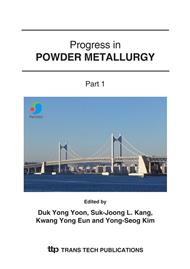p.1073
p.1077
p.1081
p.1085
p.1089
p.1093
p.1097
p.1101
p.1105
The Effect of Oxygen Addition on Oxidation Resistance and Cutting Performance of Si3N4 Ceramics
Abstract:
The effect of oxygen addition on oxidation behavior of the β-Si3N4 ceramics with 5 mass% Y2O3 and 2 or 4 mass% Al2O3 was investigated by performing oxidation tests in air at 1300° to 1400°C and cutting performance tests. These tests were intended to clarify their ware resistance as cutting tools. The results of mass change, SEM observation and composition analysis of the specimens before and after oxidation test showed that as the Al2O3 content in the β-Si3N4 ceramics increased, mass changes resulted higher oxidation during which process pores and cracks formed due to the release of N2 gas. The values of hardness and bending strength of the specimens with relatively small amount of 2 mass% Al2O3, which formed solid solution in the Si3N4 structure [Si6-zAlzOzN8-z (z = 0.1)], showed larger than those of the specimen with 4 mass% Al2O3 (z = 0.2). The specimens group added with Al2O3 of 2 mass% (Z = 0.1) also showed high wear resistance. From this, we could conclude that the mechanical properties of β-Si3N4 ceramics depending on oxygen introduction is much effective on cutting performance improvements of the cutting performance of β-Si3N4 ceramics.
Info:
Periodical:
Pages:
1089-1092
Citation:
Online since:
January 2007
Price:
Сopyright:
© 2007 Trans Tech Publications Ltd. All Rights Reserved
Share:
Citation:


